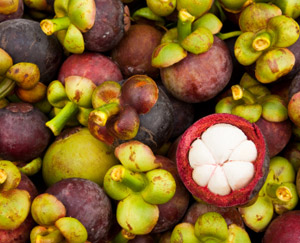Meet Mangosteen—the Antioxident Powerhouse

An exotic source of antioxidants
The flesh of the mangosteen has a delicate sweet–tart flavour. In Southeast Asia, it’s usually eaten fresh as a delectable dessert. However, what has propelled the fruit to fame is its deep purple rind, which is packed with antioxidants called xanthones.
Antioxidents help protect the body from free radicals, highly reactive compounds that interfere with cells’ ability to function normally, and may lead to more than 60 different health conditions, including the aging process, cancer, and hardening of the arteries.
Just juice
If you’re looking for fresh mangosteen in the continental United States, you used to be out of luck. Due to concerns about foreign insects hitching a ride in the fruit, it was illegal to import mangosteen. However, the USUSFDA changed its rules around importing mangosteens. It is now possible to find fresh mangosteens in supermarkets, although they might still be a rare item.
Nevertheless, you can also reap the benefits of the flavourful fruit and its antioxidant-rich rind by drinking the juice. These days, you have your choice among many brands. Choose juices that blend the rind with the fruit to get the highest antioxidant content.
How much is enough?
USDA research chemist Dr. Ronald Prior, with the Arkansas Children’s Nutrition Center, recommends getting at least 10,000 ORAC units—the ability of an antioxidant to subdue oxygen free radicals in a test tube—a day. That’s the amount you need to counteract the free radicals that your body creates when it metabolises energy.
Prior explains, “After a meal, you see a decline in plasma antioxidant capacity. So we’ve taken those numbers and are relating the need for antioxidants based on the amount of energy consumed."
Popular mangosteen juices contain anywhere from 1,600 to 2,500 ORAC units per ounce of juice. Just remember, no supplement, even an antioxidant-rich fruit juice, is a substitute for a healthy diet. So boost your antioxidant intake with mangosteen juice, but keep eating those fruits and vegetables too!
Copyright © 2024 TraceGains, Inc. All rights reserved.



 We are proud to announce that
We are proud to announce that  As the market evolves, customers increasingly request a wider variety of omega-3 options for their lipid...
As the market evolves, customers increasingly request a wider variety of omega-3 options for their lipid...  Maintaining healthy glucose levels is crucial for preventing metabolic conditions like diabetes,...
Maintaining healthy glucose levels is crucial for preventing metabolic conditions like diabetes,...  Looking at formulating a new vitamin blend? Discover
Looking at formulating a new vitamin blend? Discover 







































